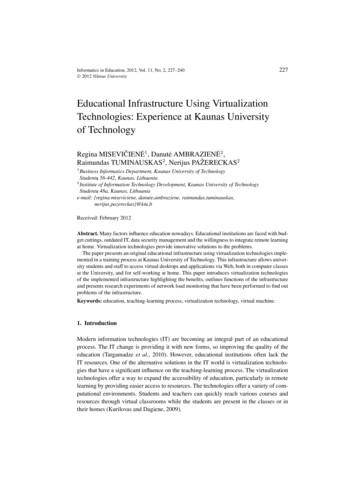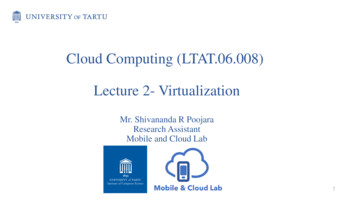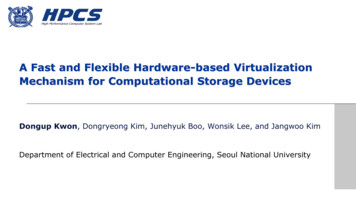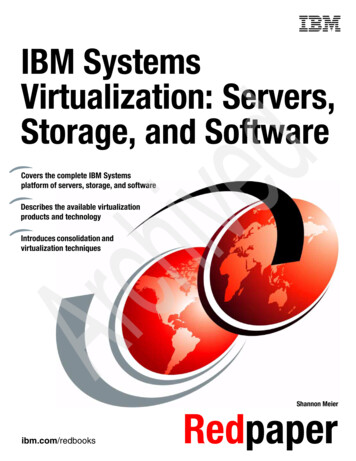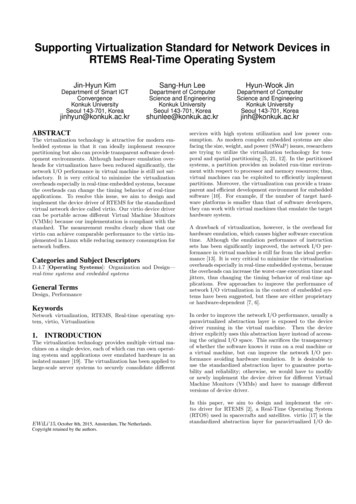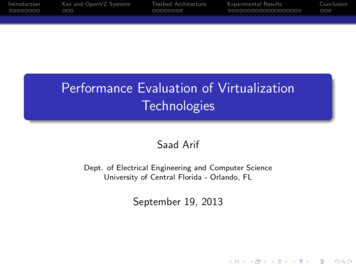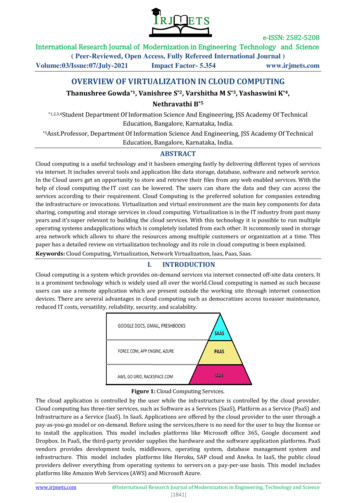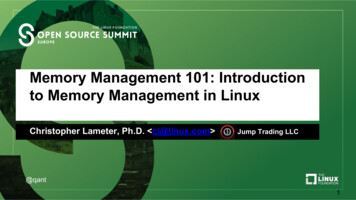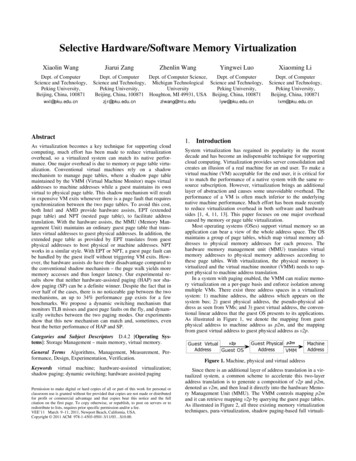
Transcription
Selective Hardware/Software Memory VirtualizationXiaolin WangDept. of ComputerScience and Technology,Peking University,Beijing, China, 100871wxl@pku.edu.cnJiarui ZangZhenlin WangYingwei LuoDept. of ComputerDept. of Computer Science,Dept. of ComputerScience and Technology, Michigan Technological Science and Technology,Peking University,UniversityPeking University,Beijing, China, 100871 Houghton, MI 49931, USA Beijing, China, 100871zjr@pku.edu.cnzlwang@mtu.eduAbstractAs virtualization becomes a key technique for supporting cloudcomputing, much effort has been made to reduce virtualizationoverhead, so a virtualized system can match its native performance. One major overhead is due to memory or page table virtualization. Conventional virtual machines rely on a shadowmechanism to manage page tables, where a shadow page tablemaintained by the VMM (Virtual Machine Monitor) maps virtualaddresses to machine addresses while a guest maintains its ownvirtual to physical page table. This shadow mechanism will resultin expensive VM exits whenever there is a page fault that requiressynchronization between the two page tables. To avoid this cost,both Intel and AMD provide hardware assists, EPT (extendedpage table) and NPT (nested page table), to facilitate addresstranslation. With the hardware assists, the MMU (Memory Management Unit) maintains an ordinary guest page table that translates virtual addresses to guest physical addresses. In addition, theextended page table as provided by EPT translates from guestphysical addresses to host physical or machine addresses. NPTworks in a similar style. With EPT or NPT, a guest page fault canbe handled by the guest itself without triggering VM exits. However, the hardware assists do have their disadvantage compared tothe conventional shadow mechanism – the page walk yields morememory accesses and thus longer latency. Our experimental results show that neither hardware-assisted paging (HAP) nor shadow paging (SP) can be a definite winner. Despite the fact that inover half of the cases, there is no noticeable gap between the twomechanisms, an up to 34% performance gap exists for a fewbenchmarks. We propose a dynamic switching mechanism thatmonitors TLB misses and guest page faults on the fly, and dynamically switches between the two paging modes. Our experimentsshow that this new mechanism can match and, sometimes, evenbeat the better performance of HAP and SP.1.lyw@pku.edu.cnXiaoming LiDept. of ComputerScience and Technology,Peking University,Beijing, China, 100871lxm@pku.edu.cnIntroductionSystem virtualization has regained its popularity in the recentdecade and has become an indispensable technique for supportingcloud computing. Virtualization provides server consolidation andcreates an illusion of a real machine for an end user. To make avirtual machine (VM) acceptable for the end user, it is critical forit to match the performance of a native system with the same resource subscription. However, virtualization brings an additionallayer of abstraction and causes some unavoidable overhead. Theperformance of a VM is often much inferior to the underlyingnative machine performance. Much effort has been made recentlyto reduce virtualization overhead in both software and hardwaresides [1, 4, 11, 13]. This paper focuses on one major overheadcaused by memory or page table virtualization.Most operating systems (OSes) support virtual memory so anapplication can bear a view of the whole address space. The OSmaintains a group of page tables, which map virtual memory addresses to physical memory addresses for each process. Thehardware memory management unit (MMU) translates virtualmemory addresses to physical memory addresses according tothese page tables. With virtualization, the physical memory isvirtualized and the virtual machine monitor (VMM) needs to support physical to machine address translation.In a system with paging enabled, the VMM can realize memory virtualization on a per-page basis and enforce isolation amongmultiple VMs. There exist three address spaces in a virtualizedsystem: 1) machine address, the address which appears on thesystem bus; 2) guest physical address, the pseudo-physical address as seen from VMs; and 3) guest virtual address, the conventional linear address that the guest OS presents to its applications.As illustrated in Figure 1, we denote the mapping from guestphysical address to machine address as p2m, and the mappingfrom guest virtual address to guest physical address as v2p.Categories and Subject Descriptors D.4.2 [Operating Systems]: Storage Management – main memory, virtual memory.General Terms Algorithms, Management, Measurement, Performance, Design, Experimentation, Verification.Keywords virtual machine; hardware-assisted virtualization;shadow paging; dynamic switching; hardware assisted pagingPermission to make digital or hard copies of all or part of this work for personal orclassroom use is granted without fee provided that copies are not made or distributedfor profit or commercial advantage and that copies bear this notice and the fullcitation on the first page. To copy otherwise, or republish, to post on servers or toredistribute to lists, requires prior specific permission and/or a fee.VEE’11 March 9–11, 2011, Newport Beach, California, USA.Copyright 2011 ACM 978-1-4503-0501-3/11/03 10.00.Figure 1. Machine, physical and virtual addressSince there is an additional layer of address translation in a virtualized system, a common scheme to accelerate this two-layeraddress translation is to generate a composition of v2p and p2m,denoted as v2m, and then load it directly into the hardware Memory Management Unit (MMU). The VMM controls mapping p2mand it can retrieve mapping v2p by querying the guest page tables.As illustrated in Figure 2, all three existing memory virtualizationtechniques, para-virtualization, shadow paging-based full virtuali-
table) and NPT (nested page table), to facilitate hardware-assistedaddress translation as illustrated by Figure 2(c) [4, 10]. We callthe paging mechanism using EPT or NPT hardware assisted paging (HAP). With the hardware assists, the MMU maintains ordinary guest page tables that translate virtual addresses to guestphysical addresses. In addition, the extended page table as provided by EPT translates from guest physical addresses to hostphysical or machine addresses. The function of NPT is similar toEPT. All evaluation in this paper is based on EPT on an Intel machine. However, we expect our design to work on an AMD machine with NPT support. With EPT or NPT, a guest page fault canbe handled by the guest itself without triggering VM exits. However, the hardware assists do have their disadvantages comparedto the conventional shadow mechanism. With HAP, an addresstranslation from virtual to host physical needs to go through boththe guest table and the extended table. This page walk yields morememory accesses and thus longer latency. The problem becomesmore prominent in 64-bit systems compared to 32-bit systemssince the page walk length is doubled in 64-bit systems.Both HAP and SP have their own advantages and disadvantages. Our experimental results on SPEC CPU2006 [9] in Figures 3and 4 show that neither HAP nor SP can be a definite winner.Both figures show the normalized execution time with respect toHAP. In eight of the twenty-nine benchmarks there is a 3% ormore performance gap between the two mechanisms. Notably, SPis 34% slower than HAP for gcc. There is a 13%, 15%, and 22%performance gap, respectively, for mcf, catusADM and tonto.Figure 2. Comparison of memory virtualization architectures140.00%At the cost of compatibility, para-virtualization can achievebetter performance than full virtualization, as well as reduce thecomplexity of the VMM. As shown in Figure 2(a), the VMMsimply replaces the mapping v2p stored in a guest page table withthe composite mapping v2m. To ensure that the guest OS functions properly after the replacement, it requires some modificationto the source code of the guest OS, which leads to the compatibility issue. For safety, the VMM needs to validate any updates to thepage table by the guest OS. By taking back write permission onthose memory pages used as the page table,the VMM preventsthe guest OS from writing to any guest page table directly. Theguest OS has to invoke hypercalls to the VMM to apply changesto its page table. XEN provides a representative hypervisor following this design [2].A software solution to support full virtualization relies on ashadow paging (SP) mechanism for address translation, where ashadow page table maintained by the VMM maps virtual addresses directly to machine addresses while a guest maintains itsown virtual to physical page table [5]. The VMM links the shadow page table to the MMU so most address translations can bedone effectively. Figure 2(b) illustrates this implementation. TheVMM has to ensure that the content in the shadow page table isconsistent with what in the guest page table. Since the guest OSdoes not know the existence of the shadow page table and willchange its guest page table independently, the VMM should perform all the synchronization work to make the shadow page tablekeep up with the guest page table. Any updates to the shadowpage table need also to be reflected in the guest page table. Allthese synchronizations will result in expensive VM exits and context switches. Moreover, the source code structure for the SP mechanism is quite complex. VMWare Workstation,VMWare ESXServer, KVM, and XEN all implement shadow paging [2, 8, 12].To avoid the synchronization cost in the SP mechanism, bothIntel and AMD provide hardware assists, EPT (extended igure 3. Normalized execution time (SPEC milczeusmpbwaves80.00%gamesszation and hardware-assisted full virtualization, take this approach. They differ in hardware support and/or the way the VMMsynchronizes v2m and v2p. Note that full virtualization does notrequire modification to the guest OS while para-virtualizationdoes. This paper focuses on a combination of the two full virtualization techniques.Figure 4. Normalized execution time (SPEC FP)Since neither HAP nor SP performs better all the time, we canlose performance no matter which one we pick as the default. Anintelligent mechanism should be able to exploit the advantages of
both HAP and SP based on the VM behavior. So we propose adynamic switching mechanism that can switch the paging modebetween HAP and SP based on the runtime behavior of the currentapplications. We name this mechanism Dynamic Switching Paging (DSP). DSP relies on online sampling of TLB misses and pagefaults to make decisions on paging mode switching. We develop aset of heuristics to assist the decision making. Our results showthat DSP is able to match or even beat the better performance ofSP and HAP for all benchmarks, either in a 32-bit system or a 64bit system. In the meantime, the overhead of DSP is negligible.The remainder of this paper is structured as follows. In Section2 we describe the design of DSP. Section 3 details an implementation of this mechanism based on XEN [2, 14]. Section 4 evaluatesDSP using some industry standard benchmarks and compares itwith HAP and SP. Section 5 discusses related work. We finallyconclude and discuss future work in Section 6.2.DSP Design2.1 DSP FunctionalityHAP is controlled by the CPU control register. By setting or resetting the corresponding control bit, we can choose whether or notto use HAP on a machine where HAP is supported. Take Intel’sEPT as an example. There is a Secondary Processor-Based VMexecution Control Register in the CPU. Bit 1 of this register, defined as “Enable EPT”, controls EPT. If this bit is set, EPT isenabled. Otherwise, it is disabled.To switch to HAP mode, the VMM should prepare a group ofpage tables as the extended page tables, which map guest physicaladdresses to host machine addresses. In Section 1, we name thisguest physical address to host machine address map the p2m map.For the extended tables to take effect, the VMM needs to transferthe root address of the top-level page directory to the hardwarevirtual machine control structure (VMCS). For most VMM implementations, the p2m map is fixed. Therefore, the content ofEPT is often fixed as well. When the extended tables are ready,we can enable EPT by setting the control bit.To switch to SP mode, we need a shadow page table. Becausethe guest page table is available in both SP mode and HAP mode,the shadow page table can be constructed based on the guest pagetable and the p2m map. The switching thus requires reconstructionof the shadow page table and resetting the EPT control bit.Since both modes need the p2m map, we keep this map intactin both modes. When switching from HAP mode to SP mode, westore the root address of EPT temporarily and restore it to thedesigned register in VMCS at the time when switching back. InSP mode, the shadow page table should be synchronized with theguest page table, while we do not need a shadow page table inHAP mode. To facilitate quick switching, one approach is tomaintain a shadow page table in HAP mode so we do not need toreconstruct it when switching to SP mode. We find that this approach damages the independence of HAP mode and also resultsin high overhead. We instead rebuild a new shadow page tableevery time we switch to SP mode. The table is destroyed whenleaving SP mode for HAP mode.To summarize, when switching from HAP mode to SP mode,store the root address of the top level page directory of the p2mmap, rebuild the shadow page table, and then disable the “EnableEPT” control bit in the Secondary Processor-Based VM-executionControl Register; when switching from SP mode to HAP mode,destroy the shadow page table, restore the root address of the toplevel page directory of the p2m map, and then turn on the “EnableEPT” control bit in the Secondary Processor-Based VM-executionControl Register.2.2 DSP Tradeoff AnalysisTo find out when is a good time to switch between the two pagingmodes, we need to understand the advantages and disadvantagesof each mode. HAP mode eliminates the expensive VM exits andcontext switches from SP mode when there are needs to synchronize the shadow page table and the guest page table. SP modeenables quicker address translation because it only needs to walkthrough the shadow page table while HAP mode needs to walkboth the guest page table and the p2m map, which doubles thenumber of memory accesses. An ideal switching policy wouldrequire predicting the number of VM exits saved by HAP modeand the number of memory accesses saved by SP mode. With anestimation of VM exit penalty and memory access latency, onecan design a cost model to determine when to switch between thetwo modes. Unfortunately, it is difficult to predict either of thetwo metrics. In HAP mode, there is no shadow page table and thusno VM exits due to shadow-guest synchronization. Although wecan monitor the TLB misses and estimate the number of pagewalks, the MMU cache available in both NPT and EPT eliminatesthis direct correlation. A TLB miss can hit the MMU cache andthus does not need to walk the page table. Both NPT and EPTcome with effective MMU translation caches [3, 4]. Nevertheless,we find that TLB misses are still closely correlated to HAP andSP performance. Rather than estimate the number of VM exits, wetake the guest OS page fault statistic as a replacement metric. Weobserve that HAP mode performs better than SP mode in the applications with a large number of page faults, such as gcc andtonto, while HAP performs worse in those applications with asmall number of page faults but intensive memory accessing and alarge number of TLB misses, such as mcf and cactusADM. Basedon the analysis above, DSP switches to HAP mode when we expect frequent page faults in the next period and to SP mode whenwe foresee frequent TLB misses. To fulfill dynamic switching, werely on historic TLB miss and page fault information to predictthe future trend and make a switching decision.2.3 DSP Switching StrategyBoth TLB miss and page fault penalties are hardware and systemdependent. To estimate the trend, in our implementation, we instead measure page fault frequency and TLB miss frequency,which is the number of page faults and the number of TLBmisses, respectively, per thousand retired instructions. To make adecision in DSP, we need a pair of system-dependent thresholdsthat guard page fault and TLB miss frequencies, respectively. Ifneither the page fault frequency nor the TLB miss frequency goesbeyond its threshold, there would be little difference betweenHAP and SP mode. DSP should stay in the current mode to avoidthe switching cost. If one metric is beyond the threshold and theother is low, DSP needs to take action and switch to the othermode. If both frequencies are high, we need to weigh the relativepenalty of each. We introduce a third metric, P-to-T ratio, as anestimation of this relative penalty. The P-to-T ratio is the pagefault frequency divided by the TLB miss frequency. A third threshold is used to guard the P-to-T ratio.We manually take a simple machine learning approach to learnthe thresholds that determine DSP switching. By training the decision model through the SPEC INT benchmarks on a 32-bit guest,we obtain a heuristic DSP switching algorithm as follows.1.If the TLB miss frequency is higher than the TLB missupper-bound threshold and the page fault frequency islower than 80 percent of the page fault upper-boundthreshold, switch from HAP mode to SP mode or stay inSP mode.
2.If the page fault frequency is higher than the page faultupper-bound threshold and the TLB miss frequency islower than 80 percent of the TLB miss upper-boundthreshold, switch from SP mode to HAP mode or stay inHAP mode.3.If both the TLB miss frequency and the page fault frequency are lower than their lower-bound thresholds, stayin the current paging mode.For the remaining cases, we will need to use the P-to-T ratio.We notice that the P-to-T ratios show a large range of fluctuationsfrom period to period. We use both a running average of recent Pto-T ratios, called historic P-to-T ratio, and the P-to-T ratio in thecurrent monitoring period to help make decision. Below is ourpolicy where step 4 helps avoid divide by 0 exceptions.4.If either the historic TLB miss frequency or the currentTLB miss frequency is zero, switch from SP to HAP orstay in HAP mode.5.If both the historic average P-to-T ratio and the currentP-to-T ratio are bigger than the P-to-T ratio upper-boundthreshold, the page fault penalty is more significant thanthe TLB miss penalty and DSP decides to switch fromSP mode to HAP mode or stay in HAP mode.6.If both the historic average P-to-T ratio and the currentP-to-T ratio are lower than the P-to-T ratio lower-boundthreshold, the TLB miss penalty is more significant thanthe page fault penalty. Now DSP switches from HAPmode to SP mode or stays in SP mode.7.If both the historic average P-to-T ratio and the currentP-to-T ratio are between the lower-bound and upperbound thresholds, neither is significant and there wouldbe little difference between the two paging modes. Inthis case, the system stays in the current mode.8.Otherwise, the historic average P-to-T ratio and the current P-to-T ratio fit into different threshold intervals. Wecannot decide the trend and the system stays in the current mode.Figure 5 summarizes the eight policies and shows theworkflow of the DSP decision algorithm where the acronyms arelisted below. equency of TLB missesFrequency of Page FaultsHistoric TLB miss frequencyHistoric average P-to-T ratioCurrent P-to-T ratioTLB miss Upper-bound thresholdTLB miss Lower-bound thresholdPage Fault Upper-bound thresholdPage Fault Lower-bound thresholdP-to-T ratio Upper-bound thresholdP-to-T ratio Lower-bound thresholdFigure 5. DSP decision diagram3.DSP Implementation on XENWe have implemented DSP in XEN 3.3.1. Domain 0 operatingsystem is CentOS 5.4 x86 64 with Linux kernel 2.6.18. DomainU operating system is CentOS 5.4 x86 32 with Linux kernel2.6.18.3.1 DSP Design in XENFigure 6 illustrates our implementation of DSP in the XEN system. Since most management operations of XEN are integrated inthe xm tools in Domain0, we add two sub-commands in the xmtools, dsp and undsp to enable or disable DSP.Figure 6. DSP implementation on XEN
We take advantage of the existing timer in XEN to sample aguest OS. In order to count the number of page faults, TLBmisses, and retired instructions in the recent period of T seconds,we start a timer in the xend service process when executing the xmdsp command. The timer will invoke the corresponding XENhypercall every T seconds, request the XEN hypervisor to collectthose statistics and decide whether to change paging mode or not.We get the number of TLB misses and retired instructionsfrom the processor performance monitor unit (PMU) in the XENhypervisor. To get the number of page faults, we add a kernelmodule in each guest OS of interest. When the guest OS starts up,the kernel module will notify the XEN hypervisor of the memoryaddress of the variable that records the number of page faults inthe guest OS. The XEN hypervisor can read the variable directlyand get the number of page faults efficiently.All virtual machines using DSP are organized as a list in thehypervisor. Whenever the timer invokes the hypercall, the XENhypervisor will only collect samples for the virtual machines inthe DSP list. A virtual machine will be removed from the listwhen it is destroyed, or when the command xm undsp is executed.If the list becomes empty, the timer in the xend process will beterminated. This implementation allows enabling or disablingDSP on each virtual machine independently.The effectiveness of DSP is greatly dependent on the thresholds of page faults, TLB misses, and P-to-T ratios. The thresholds might be quite different on different hardware platforms.Our current approach relies on machine learning and profiling tolocate appropriate thresholds for a specific machine. All thresholds can be customized by executing the xm dsp command withcorresponding parameters. Thus, a user or a system administratorcan choose a set of thresholds that fit his/her hardware platform.3.2 Major Interface FunctionsIn our implementation, we extend an existing hypercall,do hvm op, with a new operation, hvmop dsp. Both the kernelmodule in a guest OS and the DSP timer in the xend serviceprocess invoke do hvm op to interact with the XEN hypervisor.The operation, hvmop dsp, is called on the hvmop dsp branchin the do hvm op hypercall. According to the parameters,hvmop dsp will perform the following actions respectively.1.Accept the memory address of the page fault event variable (counter) in a guest OS, and translate the memoryaddress to the corresponding virtual memory address inthe VMM.2.Enable DSP on the target virtual machine and add it tothe DSP list.3.Retrieve the number of page faults, TLB misses, and retired instructions in the current sampling period, and calculate the corresponding frequencies. Call process dspto make a decision as to whether to change the pagingmode according to the strategy introduced in Section 2.3.4.Disable DSP on the target virtual machine by callingpaging stop switch, and remove the virtual machinefrom the DSP list; and if the DSP list becomes empty,stop the DSP timer in the xend service process. Paging stop switch will also switch the VM back to theformer paging mode before DSP is enabled.Two functions, paging switchto hap and paging switchto sp,are implemented to fulfill paging mode switching. The functionpaging switchto hap performs switching from SP mode to HAPmode. In order to complete the switching, it destroys the existingshadow page table, loads the root address of the p2m map to theproper register in VMCS, and modifies the Secondary ProcessorBased VM-execution Control Register to enable EPT. The function simply returns when the virtual machine is already in HAPmode.The function, paging switchto sp, conducts switching fromHAP mode to SP mode. In order to complete the switching, itsaves the root address of the p2m map, rebuilds shadow pagetables by constructing an initially empty shadow page tables, andmodifies the Secondary Processor-Based VM-execution ControlRegister to disable EPT. When SP mode starts, the shadow pagetable will be filled by demand during execution. If the virtualmachine is already in SP mode, the function simply returns.4.EvaluationIn this section, we first run a set of experiments to learn the thresholds for DSP decisions. We then validate the thresholds with adifferent set of benchmarks or a different guest OS.4.1 Experimental EnvironmentWe conduct our experiments on a PC with an Intel i7-860 processor, 8GB of memory, and a 1TB SATA hard disk. All 4 cores ofthe i7-860 processor are enabled while disabling hyperthreading.The hypervisor we use is XEN 3.3.1. We patch our DSP implementation onto it.Domain0 runs a 64-bit Linux OS, CentOS 5.4 x86 64, and isconfigured with 3 GB of memory and 2 CPU cores. We installtwo guest domains, Dom32 and Dom64, running a 32-bit and a64-bit OS, respectively. Dom32 runs CentOS 5.4 i863 with 3 GBof memory and 1 CPU core. Dom64 runs CentOS 5.4 x86 64with 3GB of memory and 1 CPU core.We choose SPEC CPU2006, since the 29 benchmarks in thesuite show a variety of memory behavior and DSP is intended tooptimize memory virtualization. A memory and CPU intensivebenchmark is more suitable than an I/O intensive benchmark toevaluate the effectiveness of DSP.Table 1. 32-bit VM SPEC INT statisticsPF per 1K inst* 107TLB miss per1K instPF*107/TLB(col. 1/col. 2)Winner400.580SP1250.5250HAP0 0.50Draw 150000 1 P900002.750000HAP0, sometimes 1000.020, sometimes40000Draw0 or 100000.30 or 30000HAPSometimes 10000 frequently 10SP 50 3.9 10SP 150000 1 230000HAP
4.2 Threshold Selection4.4 OverheadIn order to find out proper thresholds, we run SPEC INT2006 onDom32 both in SP mode and in HAP mode. We collect the sample page fault frequency, TLB miss frequency, and historical P-toT ratio every five seconds. For each benchmark, we select a typical sample value that dominates the whole benchmark. Table 1lists these samples. Based on this table, we generate thresholdsthat will result in a correct decision for DSP in most cases. Thefinal thresholds we pick are listed in Table 2.For all samples values that can help select between HAP andSP, we take their average as the final threshold, expecting it willbest fit other programs. We pick the most recent three samples tocalculate the historical average ratios. We observe that the threesample points, which denote a 15-second interval, are sufficient tosmooth a short-term change in a program. Due to the switchingoverhead, it is not worth performing switching when there is ashort burst of page faults or TLB misses. However, a longer than15 second interval may result in longer turnaround time. In otherwords, the system may stay in one mode for too long.Overhead of paging switching falls in two categories. One is theoverhead of switching from SP mode to HAP mode, and the otheris the overhead of switching from HAP mode to SP mode. Toswitch from SP to HAP, we simply load the EPT base address. Toswitch from HAP to SP, the shadow page table has to be rebuilt,and thus its overhead is larger than switching from SP to HAP.In order to measure the overhead of switching from SP toHAP, we let the VM initially run in HAP mode. For every second,we invoke a hypercall operation (H-S-H), which will switch theVM from HAP to SP, and then, before returning back to the VMfrom the hypercall, immediately switch back from SP to HAP.Though the VM has been once in SP mode, but no instruction ofthe VM has been executed in SP mode. Therefore the shadowpage table has never been actually used and it remains emptybefore switching back to HAP mode. The overhead of H-S-Hwould be larger than the overhead of single switching from SP toHAP.Similarly, to measure the overhead of switching from HAP toSP, we let the VM initially run in SP mode. For every second, weinvoke another hypercall operation (S-H-S), which will switch theVM from SP to HAP, and then switch immediately from HAPback to SP before returning to the VM. Since the shadow pagetable is completely destroyed when switching from SP to HAP,after switching back from HAP to SP, the shadow page table hasto be rebuilt. The overhead of S-H-S would be larger than theoverhead of switching from HAP to SP.Table 2. Thresholds for DSP decisionUpper-boundPage fault threshold5000x10TLB miss threshold10Lower-bound-7100 x10-70.1-7150 x10-7P-to-T ratio threshold200 x10Interval for recent history15 seconds (3 sample points)Table 4. Switching overhead of H-S-Hbenchmark4.3 Sampling Interval SelectionTable 3 shows total TLB misses, page faults and execution timesof mcf and gcc under HAP or SP only. Based on these statistics,we can estimate that the overhead of one TLB miss in HAP modecompared with SP mode is approximately 4 nanoseconds (roughly12 cycles), and the overhead of one page fault in SP mode compared with HAP mode is around 10 microseconds. Based on thetotal execution times of the two benchmarks, switching from HAPto SP can save about 100 milliseconds per second on mcf, andswitching from SP to HAP can save about 300 milliseconds persecond on gcc. If switching can bring mcf or gcc to the best paging mode for more than one second, the benefit would overcomethe overhead. As both mcf and gcc are the best cases that benefitmost from proper switching, other benchmarks would have to stayin the best paging mode for a longer time to overcome the overhead of pagin
Science and Technology, Peking University, Beijing, China, 100871 lyw@pku.edu.cn Xiaoming Li Dept. of Computer Science and Technology, Peking University, Beijing, China, 100871 lxm@pku.edu.cn Abstract As virtualization becomes a key technique for supporting cloud computing, much effort has been made to reduce virtualization
